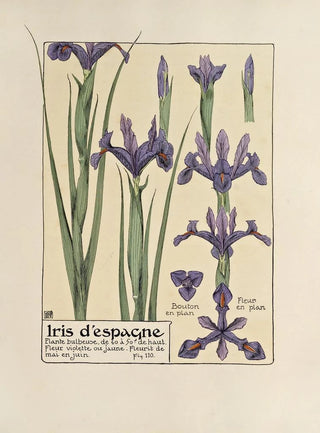Art print | Iris of Spain - Maurice Pillard Verneuil


View from behind

Frame (optional)
Spain Iris - Maurice Pillard Verneuil – Captivating Introduction
In the expansive panorama of early 20th-century decorative arts, "Spain Iris" by Maurice Pillard Verneuil stands out for its delicacy and visual poetry. This artwork, which evokes a lush garden where irises are adorned with shimmering colors, transports the viewer into a universe where nature and imagination meet. The composition is both harmonious and dynamic, offering a fascinating glimpse into the ephemeral beauty of flowers. Gazing at this piece, one feels invited to dream, to escape to sunlit lands where each petal seems to whisper secrets of nature.
Style and uniqueness of the artwork
Maurice Pillard Verneuil's style is a true homage to Art Nouveau, a movement that marked its era with its organic aesthetics and floral motifs. "Spain Iris" embodies this essence through flowing lines and sinuous shapes that intertwine gracefully. The irises, depicted in all their splendor, are enhanced with vibrant shades of blue, violet, and yellow, creating a lively tableau that evokes sunlight filtering through leaves. Verneuil's technique, which combines painting with decorative sensitivity, makes this artwork a perfect example of harmony between art and craftsmanship. Every detail, every color, seems carefully orchestrated to capture the very essence of blooming, inviting the viewer to immerse themselves in a world of floral beauty.
The artist and his influence
Maurice Pillard Verneuil, an emblematic figure of Art Nouveau, established himself as a master in the art of decoration. His work reflects an era when art was integrated into every aspect of daily life, transforming utilitarian objects into collectible pieces. Verneuil was influenced by the artistic currents of his time, but he also developed a personal style that is uniquely his own. His creations, often inspired by nature, testify to a keen sensitivity to forms and colors. By incorporating natural elements into his works, he not only celebrated the beauty of the world that

Matte finish

View from behind

Frame (optional)
Spain Iris - Maurice Pillard Verneuil – Captivating Introduction
In the expansive panorama of early 20th-century decorative arts, "Spain Iris" by Maurice Pillard Verneuil stands out for its delicacy and visual poetry. This artwork, which evokes a lush garden where irises are adorned with shimmering colors, transports the viewer into a universe where nature and imagination meet. The composition is both harmonious and dynamic, offering a fascinating glimpse into the ephemeral beauty of flowers. Gazing at this piece, one feels invited to dream, to escape to sunlit lands where each petal seems to whisper secrets of nature.
Style and uniqueness of the artwork
Maurice Pillard Verneuil's style is a true homage to Art Nouveau, a movement that marked its era with its organic aesthetics and floral motifs. "Spain Iris" embodies this essence through flowing lines and sinuous shapes that intertwine gracefully. The irises, depicted in all their splendor, are enhanced with vibrant shades of blue, violet, and yellow, creating a lively tableau that evokes sunlight filtering through leaves. Verneuil's technique, which combines painting with decorative sensitivity, makes this artwork a perfect example of harmony between art and craftsmanship. Every detail, every color, seems carefully orchestrated to capture the very essence of blooming, inviting the viewer to immerse themselves in a world of floral beauty.
The artist and his influence
Maurice Pillard Verneuil, an emblematic figure of Art Nouveau, established himself as a master in the art of decoration. His work reflects an era when art was integrated into every aspect of daily life, transforming utilitarian objects into collectible pieces. Verneuil was influenced by the artistic currents of his time, but he also developed a personal style that is uniquely his own. His creations, often inspired by nature, testify to a keen sensitivity to forms and colors. By incorporating natural elements into his works, he not only celebrated the beauty of the world that






